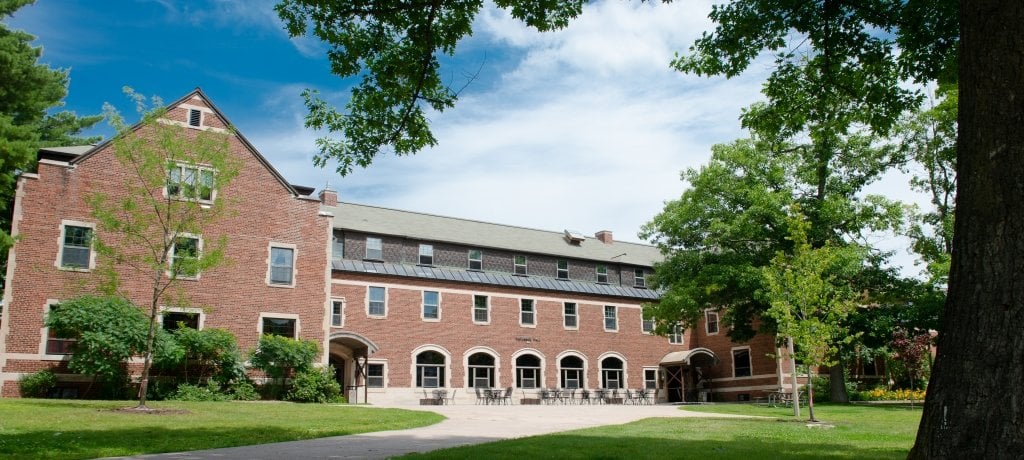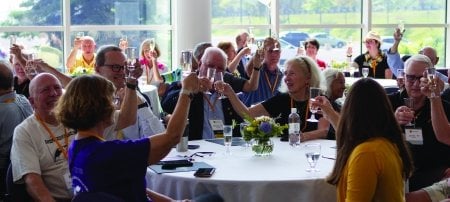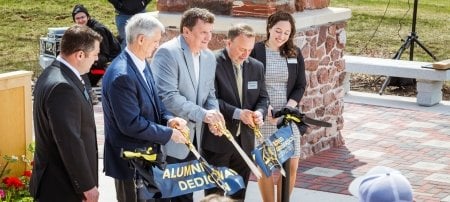People have rolled balls at targets for thousands of years. An English scholar found a painting on the wall of an Egyptian tomb: two boys playing a version of bocce ball in 5,200 B.C. With roots in Italy, modern bocce ball is played worldwide.
In 1977, a group of Michigan Tech engineering students from the Iron Mountain, Michigan, area brought the game to campus. An informal tournament was held at Winter Carnival that year on a makeshift ice court. The students continued playing in the lobby of East Coed Hall (now McNair) for the remainder of the year. Eventually, a club was formed that lasted until the late 1980s when it faded out.
Now bocce ball is coming back to the University, thanks to the efforts of alumni from that era, the Athletics Department, Housing and Residential Life, Inter-Residence Hall Council and Facilities Management. A bocce ball court, just completed this week between Douglass Houghton Hall and the Minerals and Materials Engineering Building (M&M), will be dedicated at 1:30 p.m. Friday, August 3.

In 1978, thanks to the efforts of Mike Smaby and Fred Koerschner—then mechanical engineering students—the University recognized the bocce ball club as an official student organization. The excitement spread. Club members built temporary courts at the Range Snowmobile Club and outside the old Sherman Gym. The club also constructed snow statues every Winter Carnival, with a bocce court that was used for a tournament incorporated into the design. In 1980, a permanent court was constructed behind the Gates Tennis Center. Over the years, the club had three faculty advisors: Robert Warrington, Gary Agin and Bill Bulleit. Bulleit still has club memorabilia, including the original, 40-year-old bocce balls.
Smaby graduated in 1980, staying to earn a master’s in business in 1981. Koerschner graduated in 1981. After they left, the club languished, becoming more of a social gathering. John Gierke, chair of the geological and mining engineering department, and a student in the late '80s, recalls it as “a facade to have meetings at the B&B on Thursday evenings. It was all tongue and cheek.”
Gierke has played bocce ball while ice fishing with his department, and he’s enthusiastic about the sport returning to Tech. “I think it is great to have social sports like bocce ball, frisbee, golf, ice fishing, etc. I hope that they create a facility for a bunch of different outdoor social games. Activities that foster personal interactions in the outdoors are vital to the Tech experience/culture/spirit.”
Bocce ball is played on a long, narrow court with eight large, hard plastic balls and one smaller target or object ball called a bolene (or pallina). The bolene is rolled or tossed by the team that wins a coin toss. Each team gets four balls. Then players roll or toss the bocce ball. The object is to knock the opposing team’s balls away from the bolene, or to hit the bolene to push it closer to your team’s balls. A team earns one point for each ball that is closest to the bolene. The first team to earn 12 points wins the game.
For years, Smaby and Koerschner have been toying with the idea of rebuilding the original court at Michigan Tech so another generation of students could enjoy the game. Two years ago, working with Darcy Way, an advancement officer in Athletics, the Inter-Residence Housing Council and Dan Liebau, a site engineer in Facilities Management, they started a fund drive. Their goal: $15,000.
More than 30 alumni contributed, along with matching gifts from 3M Company and Kimberly-Clark, and funding support from Michigan Tech Housing and Residential Life. The court was built and stands ready for its first tournament, scheduled right after the Friday dedication. Thirty-two players have already signed up.
Smaby hopes the court will help inspire a new generation of students interested in bocce ball.
“It’s a very social game and not real strenuous,” he says. “You can learn it very quickly. You can have fun playing within 10 minutes.”
Michigan Technological University is an R1 public research university founded in 1885 in Houghton, and is home to nearly 7,500 students from more than 60 countries around the world. Consistently ranked among the best universities in the country for return on investment, Michigan's flagship technological university offers more than 185 undergraduate and graduate degree programs in science and technology, engineering, computing, forestry, business, health professions, humanities, mathematics, social sciences, and the arts. The rural campus is situated just miles from Lake Superior in Michigan's Upper Peninsula, offering year-round opportunities for outdoor adventure.







Comments